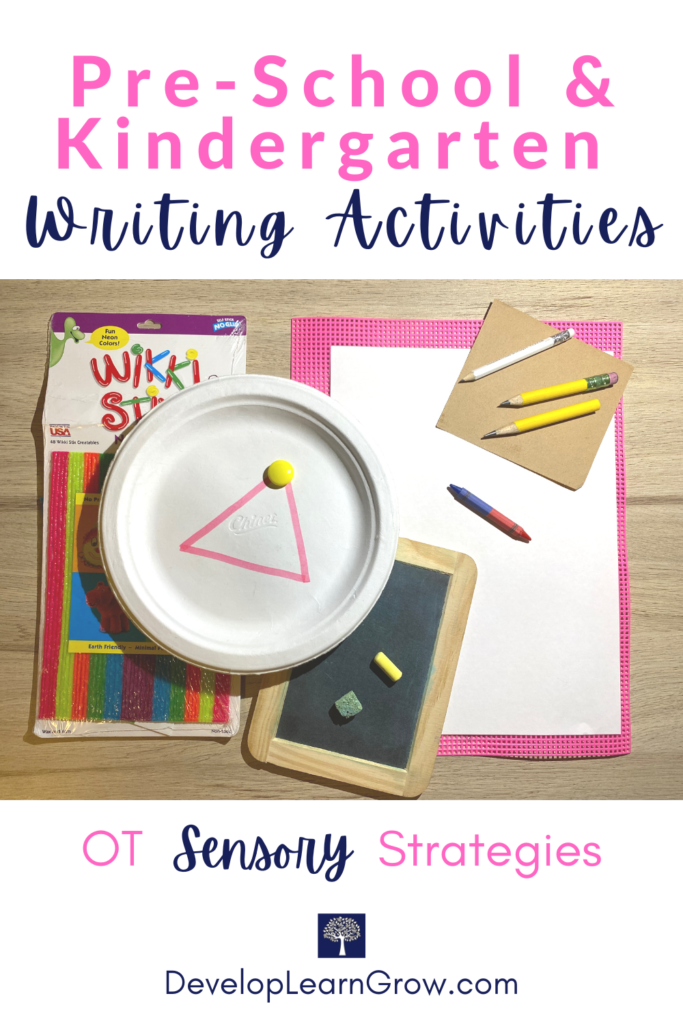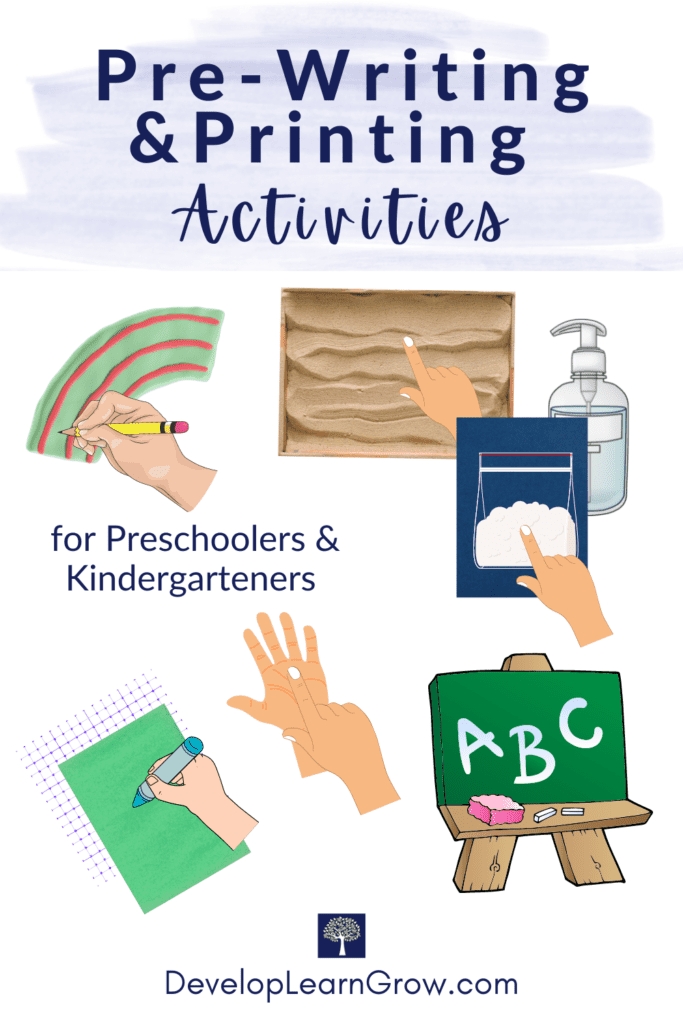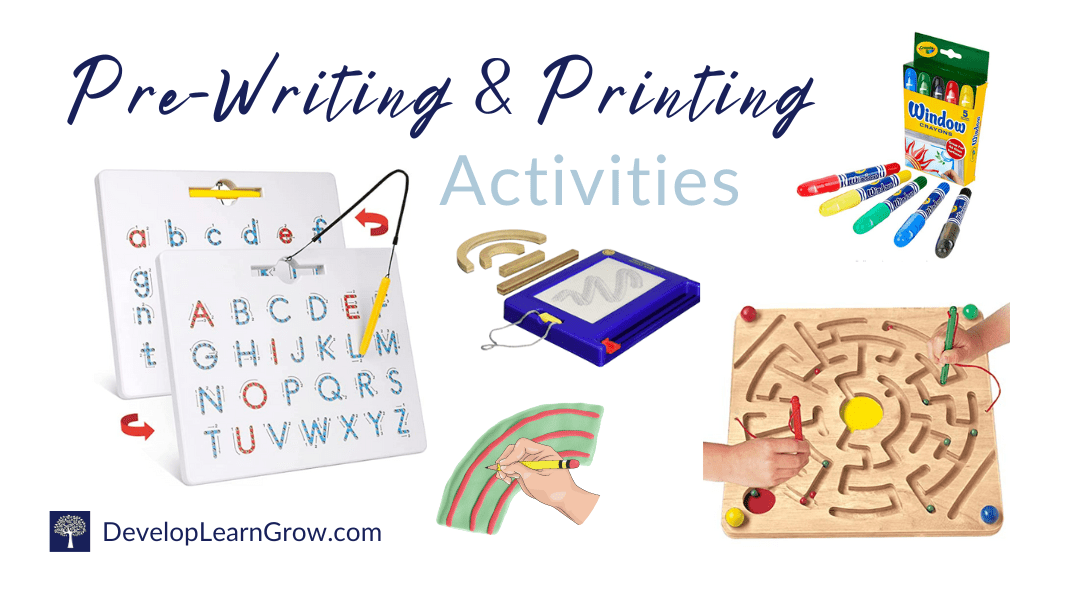Kindergarten and preschool writing activities are so fun when you use more senses! Young children learn drawing shapes and writing letters better when fun fine motor activities are a part of it. The best way to help a child practice is using more of the senses.
Before you begin practicing shapes and letters, make sure your kids are ready!
As a pediatric occupational therapist, I have come across many students who aren’t ready for printing, but their curriculums have them participating in preschool writing activities.
Additionally, I see many kindergarten classrooms that begin printing right away when students are taught letter sounds. The programs have the kiddos learning to print lowercase letters…. on 3-lined paper!!
[To be honest, it makes me cringe a little.]
A small percentage of kids have success with it… their fine motor and visual motor skills are above average. They’ve likely had proper play and developmental opportunities in their preschool years.
On the flip side, the rest of the students really struggle. In kindergarten! They don’t have the foundational pre-writing skills that they need. But they’re expected to start printing. And the expectation is to start printing on lines like first graders!
Ugh!
The child’s hand and brain is so focused on trying to use the lines that they aren’t even learning proper letter formation.
[To those of you who follow the developmental sequence and focus on pre-writing before you begin, thank you! I’ve been in many of your rooms as well and – as some say in kindergarten… it makes my heart happy!! haha]
If you’re as passionate about this as I am… help these little ones by spreading the word. Encourage and advocate for readiness skills first!
Skills Needed for Kindergarten and Preschool Writing Activities
As noted in the Pre-Writing Skills post, there are important foundational skills needed before kids start printing. (Click on the links in the list for more information.)
Body and brain readiness skills for printing and writing can include the following:
- Sensory processing skills
- Gross motor imitative skills
- Body awareness
- Core strength and stability
- Adequate posture for sitting
- Interest and motivation
- Ability to follow directions
- Attention to task
- Directionality & position understanding
- Bilateral coordination
- Crossing midline
- Hand dominance
- Pincer grip, skill finger, and grasp development
- Hand dexterity to control the end of the pencil
- Eye muscle control
- Visual perception (MANY subset skills involved)
- Hand-eye coordination
- Visual motor integration
- Visual memory (letter identification!)
Many of these skills start to develop in late toddlers and in preschoolers. They continue to develop and become more refined in preschool, kindergarten and first grade.
Occupational Therapy Tips for Pre-Writing and Writing Activities in Preschool and Kindergarten
Before I share the multi-sensory activities, I’ll cover a few basic tips that I used when working on practicing pre-writing and writing skills.
First, children’s brains, bodies and hands need multiple ways to practice different skills. They need a variety of sensory input to help build a foundation for learning.
Second, a variety of movement and brain break activities are needed to help preschoolers and kindergarteners increase their interest and attention. Then, they’ll learn to sit for longer when it actually comes to drawing and printing.
Third, in order to build the skills needed for writing, the activities have to be fun! Which is so easy for young kids… their “workdays” are filled with play, games and fun activities.
The fun activity you choose for learning has to be motivating. Find what your kids like. Follow their lead with the theme, tools, and toys that you use for the pre-writing skills activities.
Fourth, use different tools and mediums to help all the muscles in their little hands. This gives practice holding and controlling basic shapes with different motions when practicing pencil strokes needed for printing.
Additionally, pre-writing activities should also include opportunities for free drawing to develop skills and creativity. Get creative with your writing center. It does not always have to involve letters and numbers. Kids Country Learning Centers share benefits of drawing time for kids.
Finally, as often as possible, use large vertical spaces on a large piece of paper or a chalkboard. The vertical position really helps kids to see and feel the motion of what is being drawn. It helps visually, and it helps build muscles for printing.
[Amazon Affiliate links are used in the following sections for your convenience, no extra cost for you. See below for more info.]

Fun Tools to Use for Drawing, Coloring, Pre-Writing and Printing During Kindergarten and Preschool Writing Activities
As I mentioned, it’s great to try different tools and mediums for drawing forms, shapes, letters and numbers. Specific tools at certain ages help a child’s ability to develop grasping skills.
Toddlers and younger preschoolers need tools that promote a rounded palm, and tools that place their thumb on the opposite side of their other fingers. I’ll list some “drawing” tools in a sequential order.
Some items should be broken in half or even in thirds – this helps kids place only the pads of their fingers on the tools, rather than grasping with their whole hand or all of their fingers.
Fun Drawing, Coloring, Pre-Writing and Printing Tools
- Egg chalk
- Potato or small apple cut in half (used with washable paint)
- Egg crayons
- Sidewalk chalk (broken in half for all fingertips)
- Peanut crayons
- Chubby crayons
- Triangle crayons (broken in half for the pads of the thumb, index and middle fingers)
- Vibrating pens – great for added tactile and proprioceptive feedback
- Jumbo pencils (cut in half! See image)
- Jumbo crayons (broken in half or thirds)
- Regular crayons
- Q-tips (when kids are using their three fingers on tools)
- Flip crayons (good for dexterity)
- Regular dustless chalk (broken in half or thirds)
- Golf pencils or Learning Without Tears Pencils
- Regular pencils
Use this progression of drawing tools as you help your kids with pre-writing and printing.
33 Preschool and Kindergarten Writing Activities
A couple tips that I would like to share professionally as an occupational therapist: I avoid tracing letters and using dry erase markers. Too much tracing causes young kids to just cover up what they see without feeling and learning the motion. Additionally, for young children with sensory difficulties, dry erase markers tend to be too slippery and they’re not able to develop muscle memory for each letter stroke.
The following are a list of hands-on activities that help support printing. Use these activities to work on shapes, letters, numbers, and/or name writing.
1. Dance Ribbons and Scarves
Practice pre-writing motions with ribbons or scarves (this is also great for crossing midline, posture and gross motor skills.) Reinforce the writing process by first focusing on various writing strokes – using LARGE movements. Have kids move their entire arm in different positions (vertical lines, horizontal lines, diagonals, counterclockwise circles, etc. Add directionality terms such as top, middle, bottom and left-right. Use a ribbon or scarf as a large writing tool to draw letters or numbers in the air.
2. Cars or Figurines
Use cars to drive in circles, diagonal lines, paths, shapes, on tape on the floor or on a vertical surface. Or have figurines walk through straight lines and paths that make shapes. Work on vertical lines, horizontal lines, diagonals, circles, triangles, square, etc. Add arrows and give directional terms (“Start at the top and drive down!”)
3. Popsicle Sticks
Build shapes and letters with popsicle sticks. Initially, practice copying from a model. As young kids develop better perception skills, have them make shapes and forms from memory.
4. Handwriting / Learning Without Tears Wood Pieces
Practice pre-writing strokes, pre-writing shapes and capital letters. This set is great for visual perception and fine motor skills. (The program is developed by a pediatric occupational therapist. See more of her tools below.)
5. Sticks or Rocks
Incorporate nature and the outdoors into learning. Go for a walk outdoors and gather sticks and/or rocks. Build shapes and letters with them.
6. Learning Without Tears Stamp and See Screen
These are great for capitals and learning directionality. The size of the magnet pieces in this set are great for helping young kids with grasp development.
7. Play Dough
Add sensory input and work on building strength in the hands with play dough. Make sure kids build designs, letters and shapes correctly.
Additional use for play dough: flatten onto the desk top and work on pencil grip using a plastic tool or stylus to draw.
8. Roll-a-Dough Letters (Learning Without Tears)
This set uses playdoh in a packaged container with a tray for building. There are laminated capital letter and number cards with this set.
9. Pre-Writing Stencil Patterns or Large Stencil Shapes
Use the pre-writing stencils with a variety of tools to follow the paths, designs and shapes. The large stencils are great for staying inside the edge of each shape. These are both great for pencil control AND bilateral coordination.
10. Magnetic Maze Board Toy
This fun play or writing center activity works on grasping, letter recognition, visual focus, visual tracking, and visual motor control as letters are matched. (There is also a number board available.)
11. Magnet Letter Boards
These are so fun for kids who show readiness skills. Just make sure they follow the correct motions when they trace the magnet beads. The boards show directions by number, but please encourage continuous motions when making a, b, d, e, g, h, m, n, p, q, r, and u.
12. Magnets and Paper Plates
Use magnets on the top and bottom of plates with shapes or letters or numbers drawn on them – add arrows to letters and numbers to help with formation.
[Click on this link to see specific directions and examples in another blog post – kids, parents and teachers LOVE this activity!]
13. Chalk on a Chalkboard
Chalk gives great feedback to the hands when learning letter formation. I love when schools have a vertical chalkboard to use for the wet-dry-try method with sponge cubes. If there’s no large chalkboard, I use the small slate chalkboard from Learning Without Tears. It’s a fun activities that my students have always loved.
14. Chalk on Large Construction Paper
When chalkboards are not available, large pieces of construction paper combined with the chalk are a great way to give feedback to improve muscle memory. Small pieces of chalk are great for building strength to work on pencil grip.
15. Window Crayons on a Glass Door Window
These provide more resistance than markers. The resistance gives more sensory feedback to help increase muscle memory. Break them in half to improve grasping skills. The scrubbing to clean it off is also a great way to work on arm strength and crossing midline!
16. Dry Erase Crayons on a Whiteboard or Whiteboard Table
Again, these provide increased resistance to the fine motor muscles. This helps the brain learn the motions better. Especially for kids who need more proprioceptive input and feedback.

17. Shaving Cream
This is such a classic and fun activity. It’s an easy way to give kids tactile input when practicing formations.
So many kids are a little picky with textures, this is important for the brain and hands. Add sand or salt for even more texture for young kids who tolerate the smooth texture.
18. Sand Tray
This cool kit comes with letter cards – ready to go for your writing center. Kids can isolate and use their index finger, use plastic tools, or use cotton swabs to draw in these. You can also rub chalk shavings into the sand to create fun colors!
19. Salt Tray
Sprinkle salt onto a tray or paper plate. Use a dark background with white salt. Rub pastel chalk shavings or subtle spices and herbs for color and a seasonal scent.
20. Rice Tray
Mix food coloring with dry rice to increase visual stimuli. (Make sure it’s fully dry before placing on your tray.) Skip the food coloring, and add a thin layer of water to the rice tray to change the texture.
21. Pasta Tray
Similar to the rice tray! Add food coloring, add a little water, and/or crush the pasta. Use different sizes and types of pasta on different trays to vary the texture and feeling for the index finger.
22. Squishy Bags
Fill Ziploc bags with finger paint or hair gel. Add glitter or confetti for added visual interest. Make sure whatever you choose, you place it over a contrasting firm surface. Use the index finger for drawing.
23. Wikki Sticks
Bend and form shapes, letters or numbers before tracing with fingers (following the correct directions.) Stick to a vertical surface for added core and shoulder work, as well as improved visual presentation.
24. Pipe Cleaners
Bend and form pipe cleaners into different shapes and numbers. Use a magnet wand to pick them up in a certain sequential order in your writing center.
25. Flashlight or Laser Light Pointer
Work on visual tracking, memory, imagery, closure, etc with this cool activity. Draw and write with the lights on a wall, ceiling, floor, desktop, etc. Make sure to pick contrasting, plain backgrounds for this activity. Darken the room when possible.
26. Draw on the Carpet with the Index Finger
During circle time, what a simple way to add tactile feedback to the fingers than using your carpet. Make sure students are squared up (all facing the same way) when they draw or write with their index finger. This helps them see and form each shape, letter or number correctly.
27. Palm or Forearm Drawing
Have kids use their index finger to practice drawing on their opposite palm or opposite bare forearm. Extra tactile input to the palms gives great input to the brain. And kids are able to control and expect the input as they do it themselves.
28. Partner Drawing on Back
Kids pair up; one draws a shape, letter or number on his/her partner’s back. The partner guesses what is drawn. (Do you remember this one when you were younger?- I loved it!)
29. Draw on Paper Placed on Top of Sandpaper
Using a pencil or other writing tool to draw on paper placed over sandpaper. This is a great way to provide extra input to the muscles. It helps your kids who need more motor feedback.
30. Use a Crayon on Paper Placed on Top of a Bumpy Craft Screen
This is a great sensory activity (I actually remember doing this when I was in kindergarten!) I buy craft screens and place construction or printing paper over top. The crayon leaves a great texture for tracing with the finger after the shape is drawn.
31. Tear Tissue Paper to Build Letters and Numbers
Tearing small pieces of paper builds bilateral skills and fine motor strength. Building each shape or letter helps develop visual perception as well. It works on position in space and directionality.
32. Cotton Swabs and Paint
Work on visual motor skills and grasp development with this fun activity. Kids dip the cotton swab into a little paint.
They can make lines to fill in outlines or they can dab dots inside shape, letter or number outlines. Just make sure they follow the proper motions to form each one.
33. Simple Mazes
Mazes are one of my favorite activities to work on pencil control, visual tracking, motor control, and hand-eye coordination. These fine motor skills are so important for writing.
Find mazes for your writing center that focus on pre-writing strokes and diagonal lines.
Related Posts for Pre-Writing and Printing for Preschool and Kindergarten
For more ways to help your kiddos, especially when you start teaching actual printing, check out Form Letters Properly with These 9 Helpful Tips. There are also links to handwriting programs in this post.
Make sure kids sit with good posture. Explore Flexible Seating Options to help with posture and attention. Incorporate core exercises as needed to give their bodies stability for fine motor skills.
For more fun OT activities and games that support pre-writing and writing:
How to Improve Reading with 15+ Visual Skills Activities
42 Easy Visual Perceptual Activities to Support Learning
Tactile Learning: A Unique Hands on Activity
An Easy Visual Motor Activity Using Magnets (Here’s the link again, in case you missed it in the list of activities.)
Mechanical Pencils vs. Wooden Pencils
[Amazon affiliate links are used in this post for your convenience. There’s no additional cost for you. If you choose to click on an Amazon link and make a purchase, Develop Learn Grow may earn a small commission. See full Disclaimer and Privacy Policy for more information.]



0 Comments